Application of Inelastic Method and Its Comparison with Elastic Method for the Assessment of In-Box LOCA Event on EU DEMO HCPB Breeding Blanket Cap Region
Abstract
:1. Introduction
2. Materials and Methods
2.1. Thermal Analysis
- Plasma heat flux on the plasma-facing surface;
- Nuclear heating as spatially varying heat generation within each material;
- Helium coolant flow modelled as a 1-dimensional fluid flow with a constant, average heat transfer coefficient;
- Bulk helium coolant temperatures assumed as uniform ambient temperatures at the corresponding surfaces with conservative heat transfer coefficients;
- Bonded thermal contact defined between all surfaces that are in contact with each other;
- Constant gap thermal conductance value corresponding to the thermal conductivity of helium at relevant pressure is used to define thermal contact between closely spaced surfaces;
- Symmetry boundary conditions on the boundary section surfaces.
2.2. Linear-Elastic Structural Analysis
2.3. Assessment according to Elastic Analysis Criteria
2.4. Nonlinear-Inelastic Structural Analysis
2.5. Assessment according to the Inelastic Criteria
3. Results
3.1. Elastic Analysis Results and Assessment
3.2. Inelastic Analysis Results and Assessment
4. Discussion
5. Conclusions and Outlook
- Material hardening behavior after the uniform strain point is not precisely known. Conventional uniaxial tension test data is affected by the necking at the uniform strain point and may not be valid after necking. Since Eurofer material has very low uniform strain even at unirradiated conditions, the hardening behavior at higher strains needed to be understood.
- It is assumed that the failure strain–triaxial relationship for Eurofer is as represented in Figure 6, estimated from the equation for SDC-IC ILFED criteria. However, it is known that this equation may not properly represent the material failure dominated by void nucleation at low triaxiality values as opposed to the failure dominated by void growth at high triaxiality. Even at high triaxiality values, the relationship needs to be verified for Eurofer97 material.
- As described in Section 2.4, the work here is performed using tensile stress–strain data at unirradiated conditions. Since at irradiated conditions, the yield stress and ultimate stress increases due to hardening, it is assumed that the unirradiated stress–strain curve is conservative. However, the plastic flow localization is an instability phenomenon and hence it could be affected by any change in the hardening behavior.
- For the HCPB BB, component level tests under similar operating conditions (high secondary-thermal loads combined with relatively low primary loads) could be performed to validate the applicability of IPFL damage limits against the more relaxed ILFED damage limits.
Author Contributions
Funding
Institutional Review Board Statement
Informed Consent Statement
Data Availability Statement
Acknowledgments
Conflicts of Interest
References
- Donné, A.J.H. The European Roadmap towards Fusion Electricity. Philos. Trans. R. Soc. Math. Phys. Eng. Sci. 2019, 377, 20170432. [Google Scholar] [CrossRef] [Green Version]
- Federici, G.; Boccaccini, L.V.; Cismondi, F.; Gasparotto, M.; Poitevin, Y.; Ricapito, I. An Overview of the EU Breeding Blanket Design Strategy as an Integral Part of the DEMO Design Effort. Fusion Eng. Des. 2019, 141, 30–42. [Google Scholar] [CrossRef]
- Raffray, A.R.; Calcagno, B.; Chappuis, P.; Fu, Z.; Furmanek, A.; Jiming, C.; Kim, D.-H.; Khomiakov, S.; Labusov, A.; Martin, A.; et al. The ITER Blanket System Design Challenge. Nucl. Fusion 2014, 54, 033004. [Google Scholar] [CrossRef] [Green Version]
- Hernández, F.A.; Pereslavtsev, P.; Zhou, G.; Kang, Q.; D’Amico, S.; Neuberger, H.; Boccaccini, L.V.; Kiss, B.; Nádasi, G.; Maqueda, L.; et al. Consolidated Design of the HCPB Breeding Blanket for the Pre-Conceptual Design Phase of the EU DEMO and Harmonization with the ITER HCPB TBM Program. Fusion Eng. Des. 2020, 157, 111614. [Google Scholar] [CrossRef]
- Cismondi, F.; Kecskes, S.; Aiello, G. HCPB TBM Thermo Mechanical Design: Assessment with Respect Codes and Standards and DEMO Relevancy. Fusion Eng. Des. 2011, 86, 2228–2232. [Google Scholar] [CrossRef]
- Hernández, F.; Cismondi, F.; Kiss, B. Thermo-Mechanical Analyses and Assessment with Respect to the Design Codes and Standards of the HCPB-TBM Breeder Unit. Fusion Eng. Des. 2012, 87, 1111–1117. [Google Scholar] [CrossRef]
- Zhou, G.; Hernández, F.; Boccaccini, L.V.; Chen, H.; Ye, M.Y. Preliminary Structural Analysis of the New HCPB Blanket for EU DEMO Reactor. Int. J. Hydrog. Energy 2016, 41, 7053–7058. [Google Scholar] [CrossRef]
- Zhou, G.; Hernández, F.; Boccaccini, L.V.; Chen, H.; Ye, M.Y. Preliminary Steady State and Transient Thermal Analysis of the New HCPB Blanket for EU DEMO Reactor. Int. J. Hydrog. Energy 2016, 41, 7047–7052. [Google Scholar] [CrossRef]
- Hernández, F.; Pereslavtsev, P.; Kang, Q.; Norajitra, P.; Kiss, B.; Nádasi, G.; Bitz, O. A New HCPB Breeding Blanket for the EU DEMO: Evolution, Rationale and Preliminary Performances. Fusion Eng. Des. 2017, 124, 882–886. [Google Scholar] [CrossRef]
- Zhou, G.; Hernández, F.; Boccaccini, L.V.; Chen, H.; Ye, M. Design Study on the New EU DEMO HCPB Breeding Blanket: Thermal Analysis. Prog. Nucl. Energy 2017, 98, 167–176. [Google Scholar] [CrossRef]
- Zhou, G.; Hernández, F.A.; Zeile, C.; Maione, I.A. Transient Thermal Analysis and Structural Assessment of an Ex-Vessel LOCA Event on the EU DEMO HCPB Breeding Blanket and the Attachment System. Fusion Eng. Des. 2018, 136, 34–41. [Google Scholar] [CrossRef] [Green Version]
- Zeile, C.; Hernández, F.A.; Maione, I.A.; Zhou, G.; Bachmann, C. Structural Assessment of the HCPB Breeding Blanket Segments in the EU DEMO Reactor under Normal Operation and a Central Plasma Disruption. Fusion Eng. Des. 2018, 136, 335–339. [Google Scholar] [CrossRef]
- Hernández, F.; Arbeiter, F.; Boccaccini, L.V.; Bubelis, E.; Chakin, V.; Cristescu, I.; Ghidersa, B.-E.; Gonzalez, M.; Hering, W.; Hernandez, T.; et al. Overview of the HCPB Research Activities in EUROfusion. IEEE Trans. Plasma Sci. 2018, 46, 2247–2261. [Google Scholar] [CrossRef]
- Zhou, G.; Hernández, F.; Zeile, C. A Methodology for Thermo-Mechanical Assessment of in-Box LOCA Events on Fusion Blankets and Its Application to EU DEMO HCPB Breeding Blanket. Kerntechnik 2018, 83, 256–260. [Google Scholar] [CrossRef] [Green Version]
- Aktaa, J.; Kecskés, S.; Cismondi, F. Non-Linear Failure Analysis of HCPB Test Blanket Module. Fusion Eng. Des. 2012, 87, 1085–1090. [Google Scholar] [CrossRef]
- Aktaa, J.; Kecskés, S.; Pereslavtsev, P.; Fischer, U.; Boccaccini, L.V. Non-Linear Failure Analysis of HCPB Blanket for DEMO Taking into Account High Dose Irradiation. Fusion Eng. Des. 2014, 89, 1664–1668. [Google Scholar] [CrossRef]
- Aktaa, J.; Carin, Y.; Vallory, J. Non-Linear Assessment of Critical Failure Modes in the First Wall of the European TBM. Fusion Eng. Des. 2018, 128, 223–230. [Google Scholar] [CrossRef] [Green Version]
- Jin, X.Z. Preliminary Safety Analysis of LOCAs in One EU DEMO HCPB Blanket Module. Fusion Eng. Des. 2017, 124, 1233–1236. [Google Scholar] [CrossRef]
- Stonehouse, M.; Seipp, T.G.; Kanamaru, S.; Morrison, S. A Novel Comparison of Design-by-Analysis Methods. J. Press. Vessel. Technol. 2012, 134, 054502-1–054502-4. [Google Scholar] [CrossRef]
- Zhu, X.-K. Strength Criteria Versus Plastic Flow Criteria Used in Pressure Vessel Design and Analysis. J. Press. Vessel. Technol. 2016, 138, 041402-1–041402-7. [Google Scholar] [CrossRef]
- Fursdon, M.; You, J.-H.; Li, M. Towards Reliable Design-by-Analysis for Divertor Plasma Facing Components—Guidelines for Inelastic Assessment (Part 1: Unirradiated). Fusion Eng. Des. 2019, 147, 111234. [Google Scholar] [CrossRef]
- Fursdon, M.; You, J.-H.; Barrett, T.; Li, M. A Hybrid Analysis Procedure Enabling Elastic Design Rule Assessment of Monoblock-Type Divertor Components. Fusion Eng. Des. 2018, 135, 154–164. [Google Scholar] [CrossRef] [Green Version]
- AFCEN. RCC-MRx 2012: Design and Construction Rules for Mechanical Components of Nuclear Installations. Addenda Included; AFCEN: Courbevoie, France, 2013. [Google Scholar]
- ITER. SDC-IC: Structural Design Criteria for In-vessel Components; ITER: Saint-Paul-lès-Durance, France, 2012. [Google Scholar]
- Aiello, G.; Aktaa, J.; Cismondi, F.; Rampal, G.; Salavy, J.-F.; Tavassoli, F. Assessment of Design Limits and Criteria Requirements for Eurofer Structures in TBM Components. J. Nucl. Mater. 2011, 414, 53–68. [Google Scholar] [CrossRef]
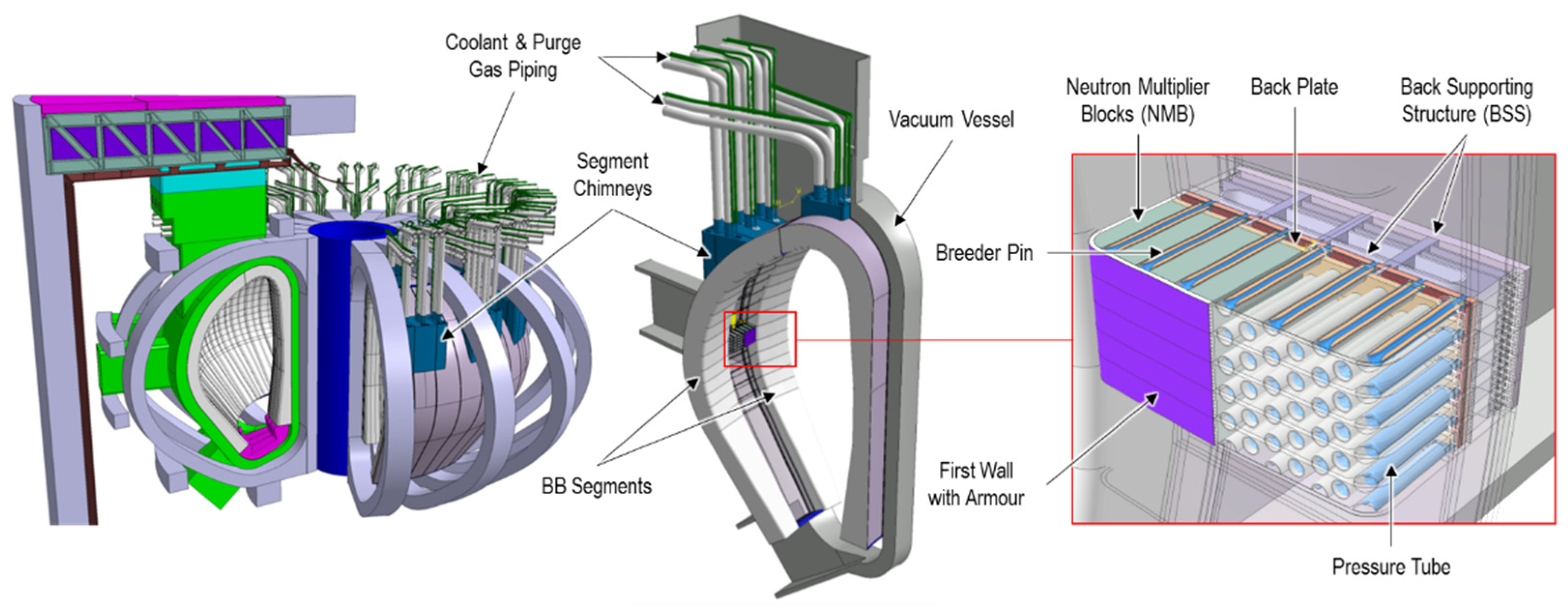
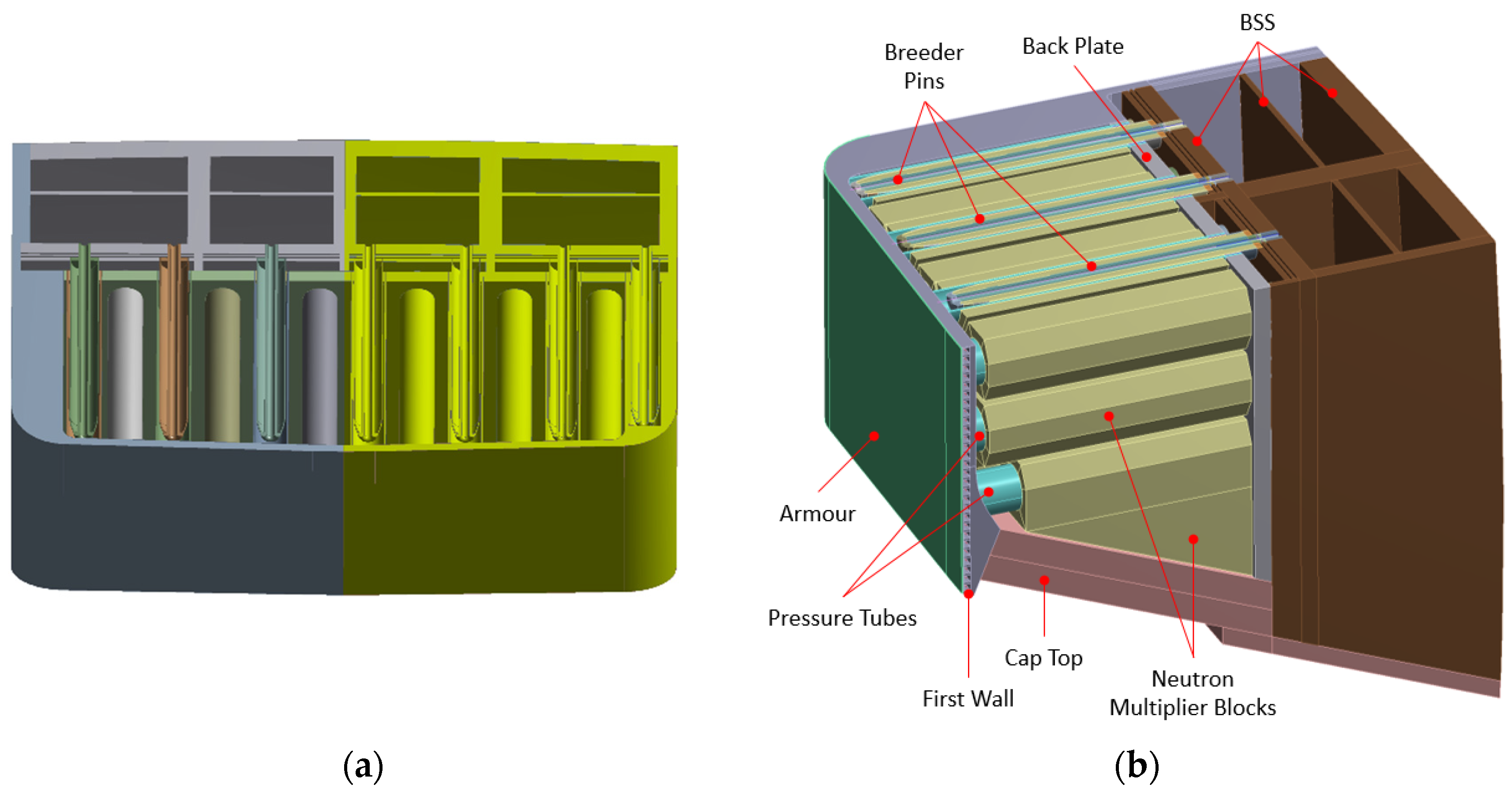
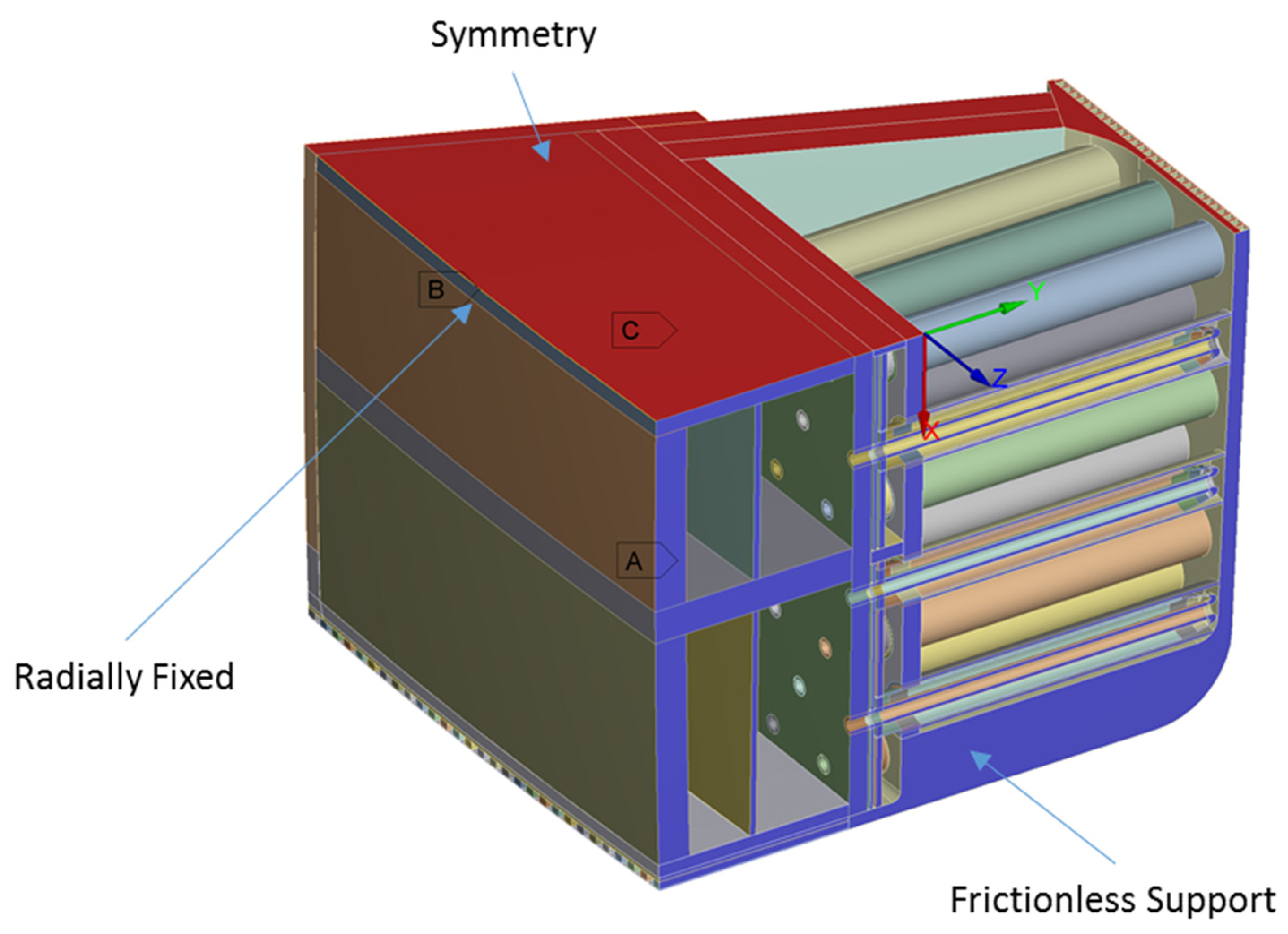
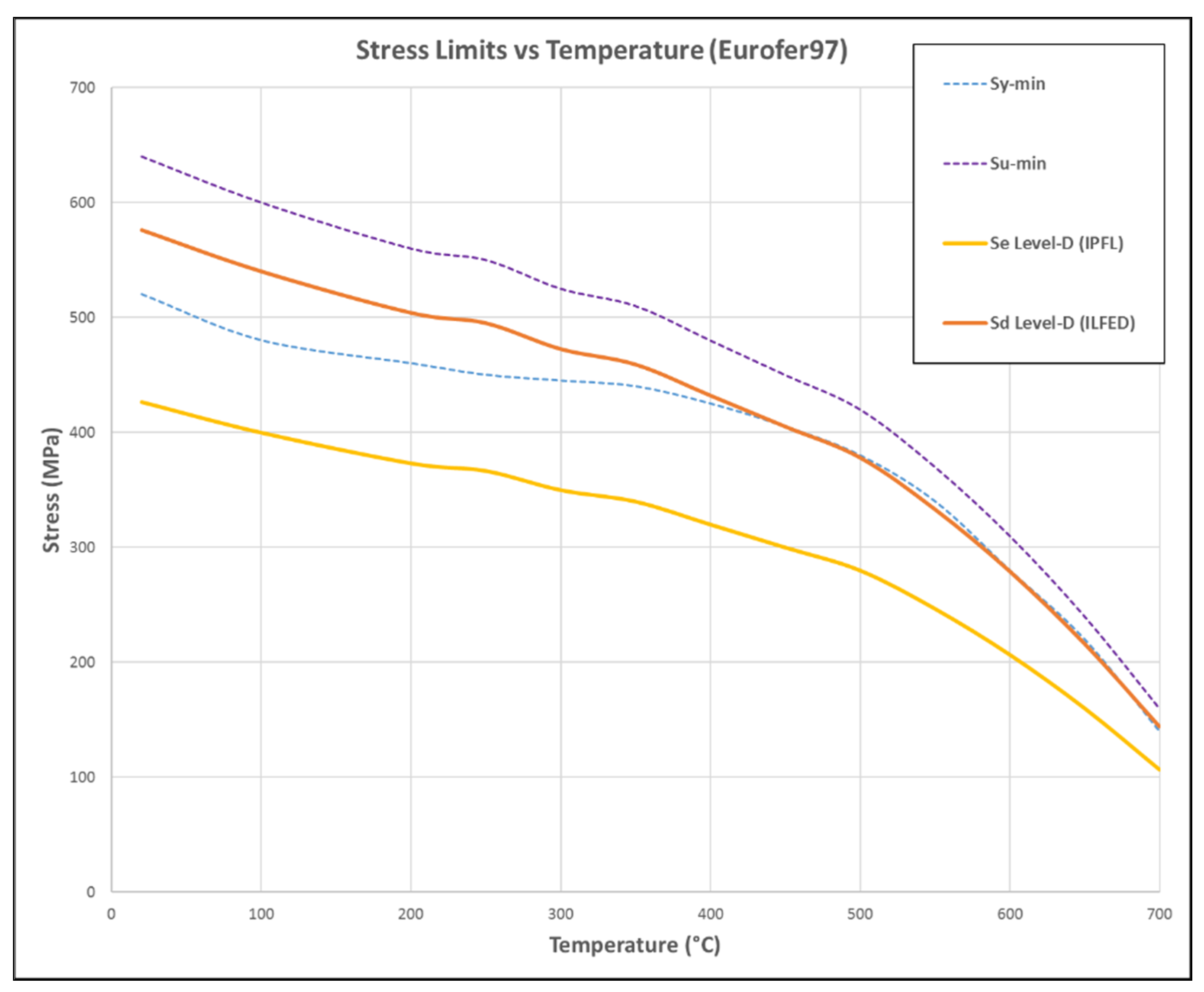
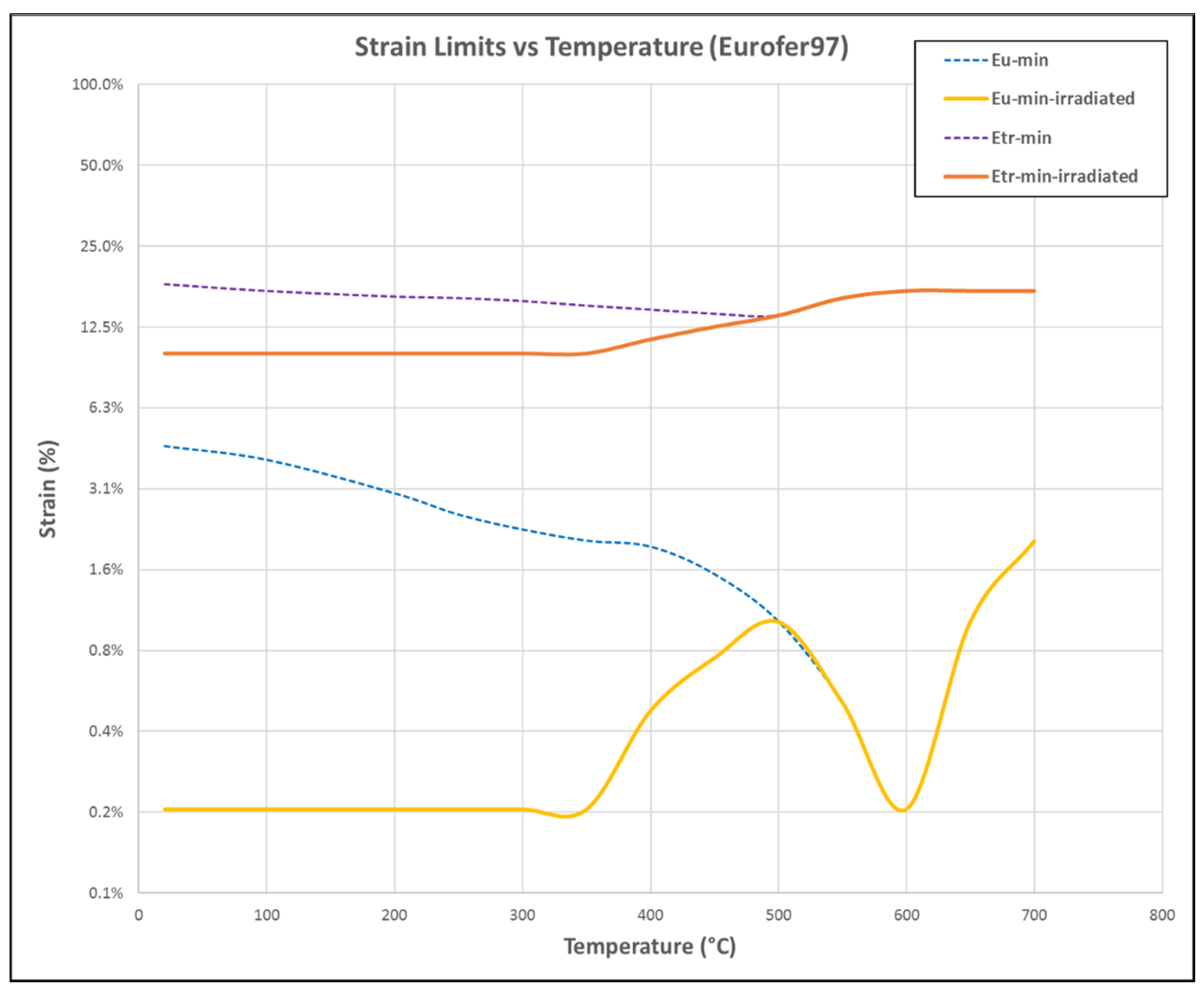
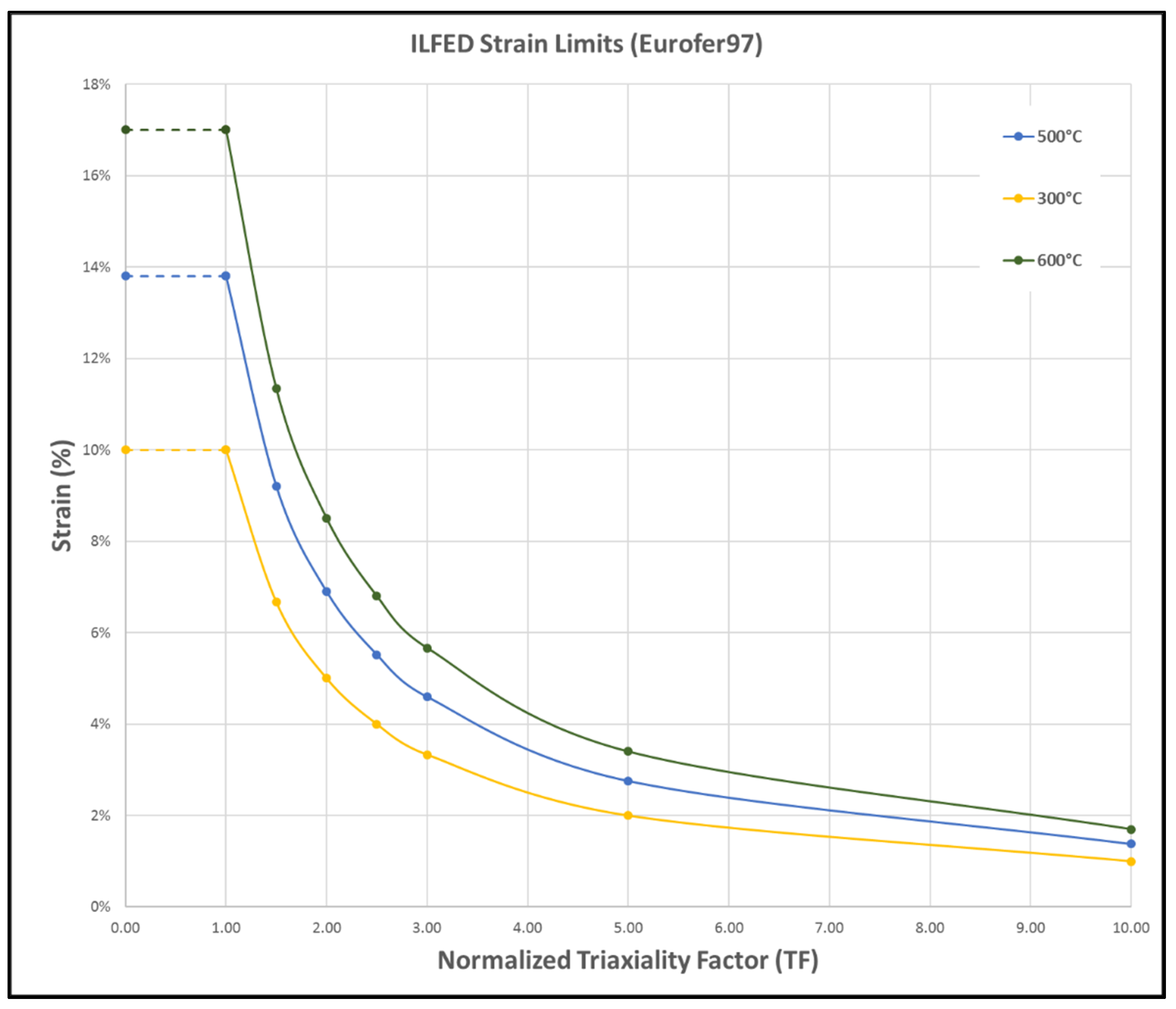
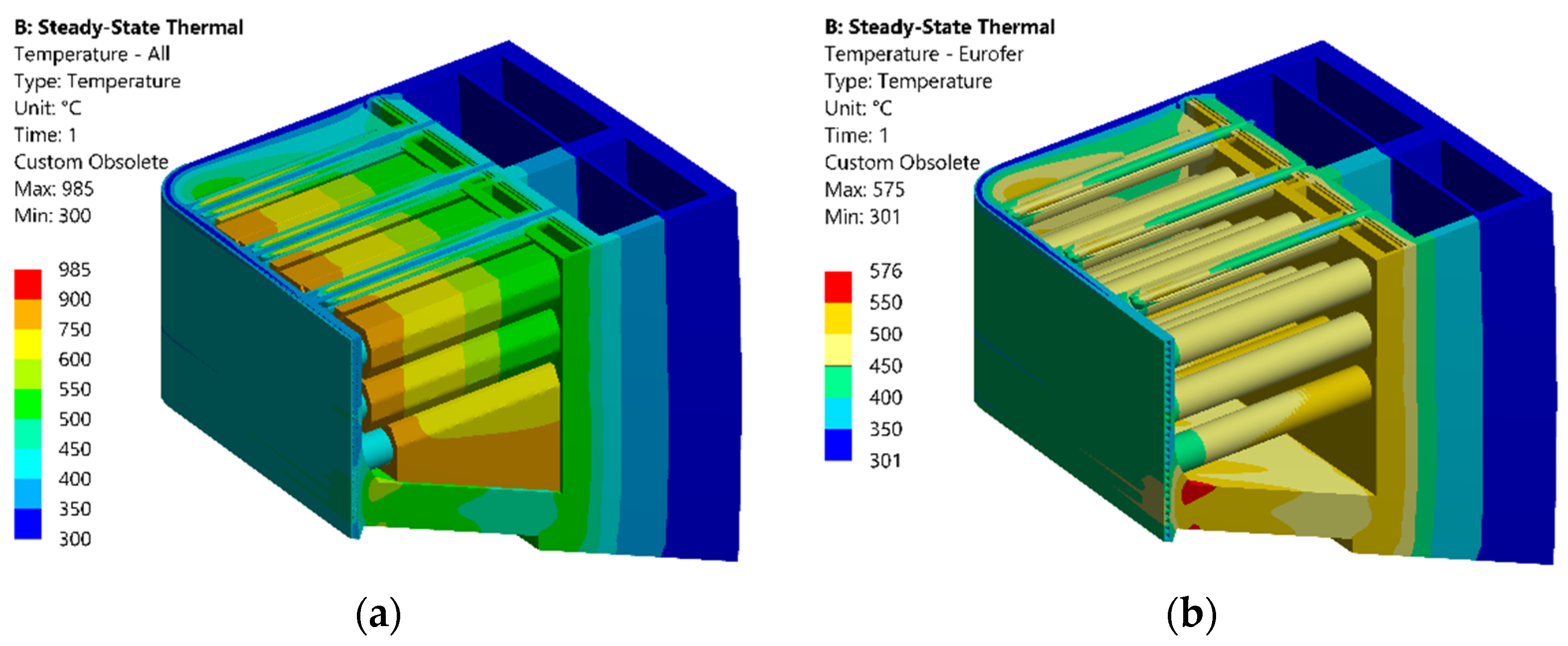
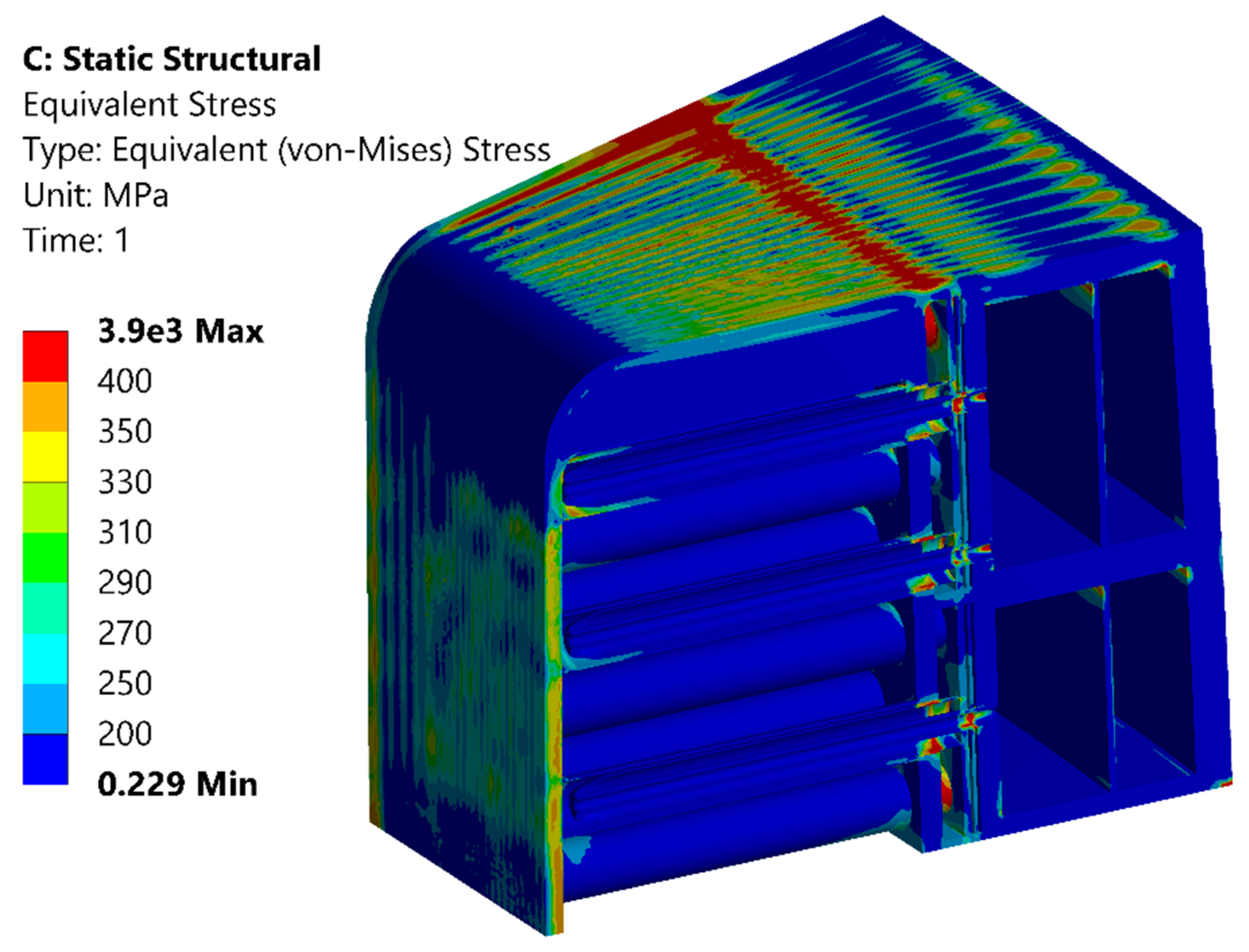
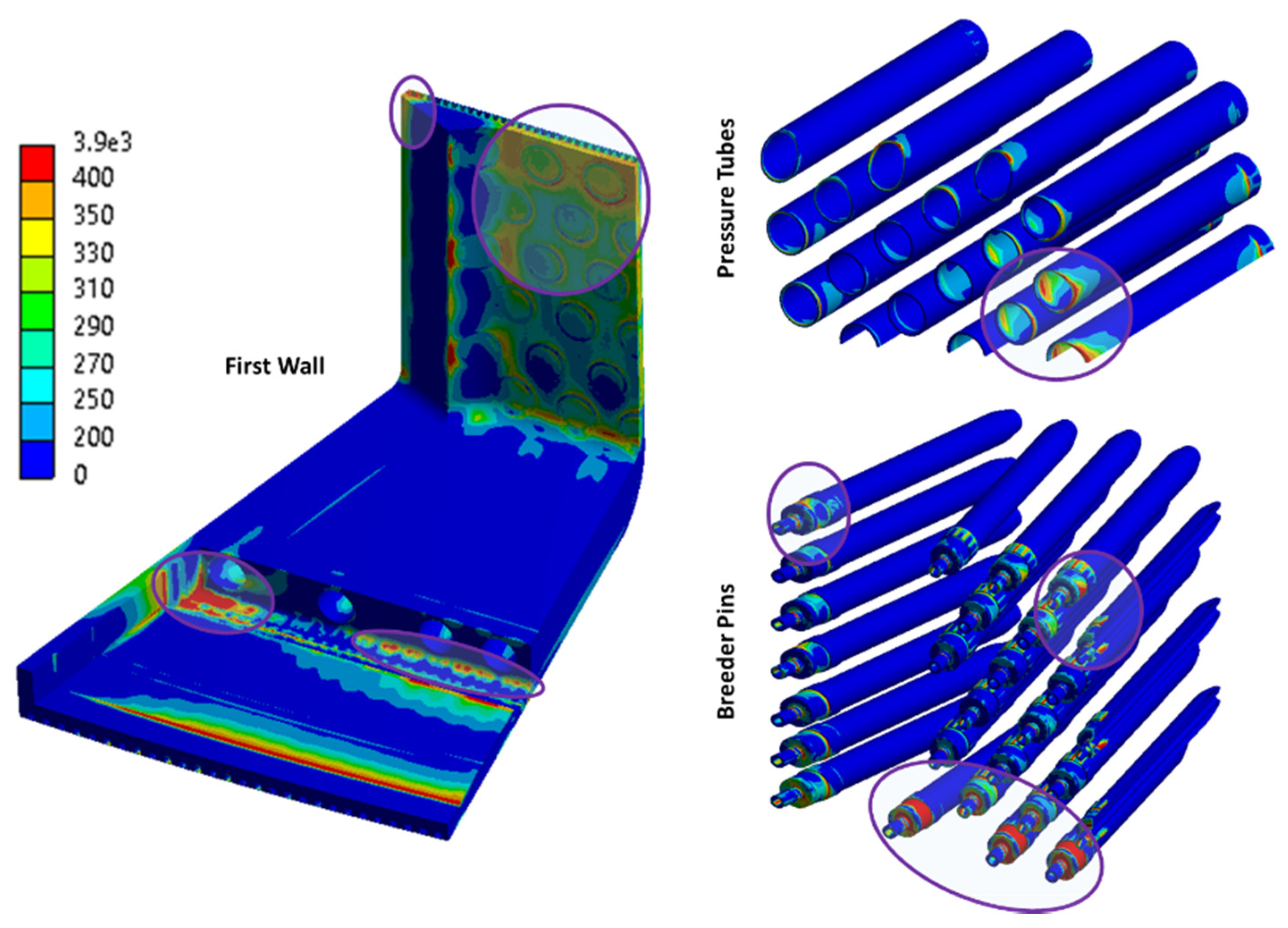
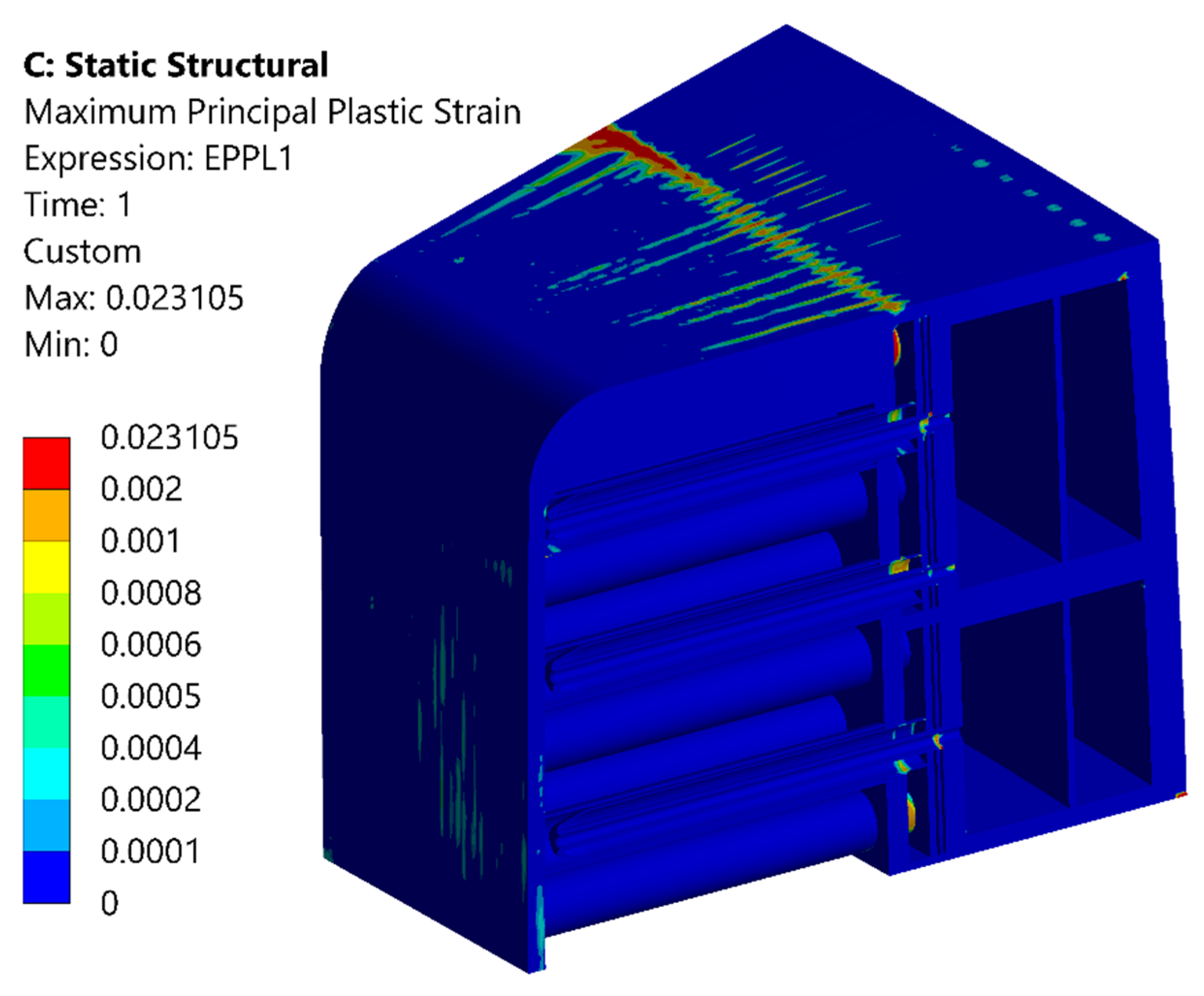
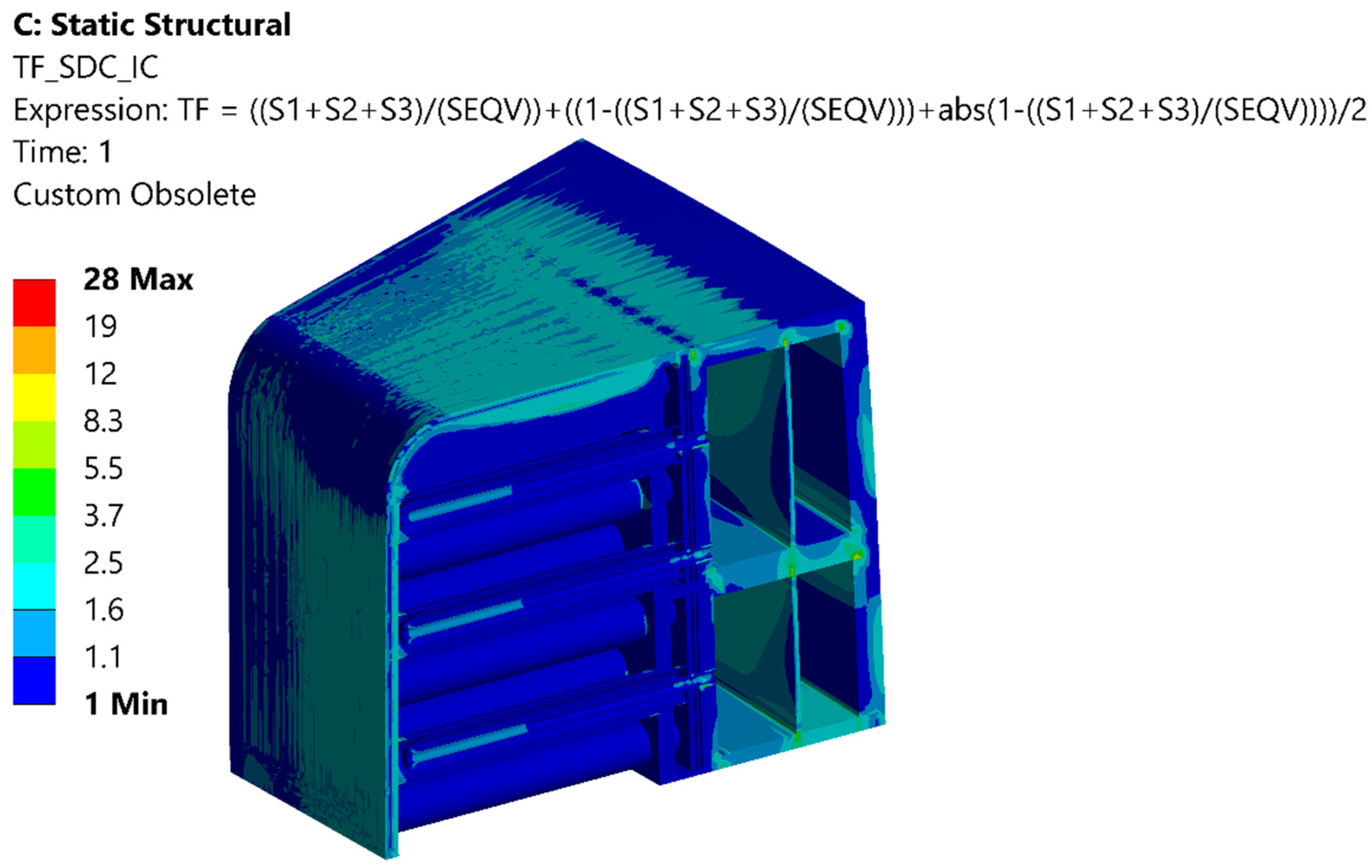
| Part | Loc. | Taverage (°C) | (MPa) | (MPa) | IPFL Margin (%) | Tpoint (°C) | (MPa) | (MPa) | ILFED Margin (%) |
|---|---|---|---|---|---|---|---|---|---|
| Cap Top | A | 480 | 68 | 287 | 76% | 514 | 211 | 388 | 46% |
| B | 488 | 39 | 283 | 86% | 521 | 199 | 382 | 48% | |
| C | 465 | 201 | 295 | 32% | 466 | 300 | 398 | 25% | |
| D | 471 | 276 | 292 | 5% | 474 | 308 | 394 | 22% | |
| E | 384 | 282 | 329 | 14% | 386 | 311 | 444 | 30% | |
| F | 551 | 94 | 244 | 62% | 572 | 104 | 330 | 68% | |
| G | 518 | 167 | 269 | 38% | 524 | 237 | 354 | 33% | |
| First Wall | A | 338 | 740 | 342 | Failed | 351 | 801 | 462 | Failed |
| B | 341 | 569 | 341 | Failed | 353 | 584 | 460 | Failed | |
| C | 381 | 576 | 330 | Failed | 380 | 585 | 445 | Failed | |
| D | 386 | 573 | 328 | Failed | 388 | 598 | 443 | Failed | |
| E | 397 | 300 | 324 | 7% | 401 | 339 | 438 | 23% | |
| F | 370 | 443 | 333 | Failed | 370 | 446 | 450 | 1% | |
| G | 390 | 331 | 327 | Failed | 396 | 378 | 441 | 14% | |
| H | 391 | 341 | 326 | Failed | 397 | 354 | 441 | 20% | |
| I | 495 | 333 | 279 | Failed | 496 | 359 | 377 | 5% | |
| J | 384 | 272 | 329 | 17% | 395 | 338 | 444 | 24% | |
| Back Plate | A | 511 | 229 | 270 | 15% | 514 | 241 | 364 | 34% |
| B | 523 | 149 | 262 | 43% | 524 | 169 | 354 | 52% | |
| C | 516 | 187 | 267 | 30% | 516 | 253 | 360 | 30% | |
| BSS | A | 516 | 210 | 267 | 21% | 516 | 284 | 360 | 21% |
| B | 514 | 222 | 268 | 17% | 514 | 276 | 362 | 24% | |
| Pressure Tubes | A | 414 | 299 | 318 | 6% | 414 | 363 | 429 | 15% |
| B | 441 | 328 | 306 | Failed | 446 | 333 | 413 | 20% | |
| C | 442 | 316 | 306 | Failed | 446 | 321 | 413 | 22% | |
| D | 409 | 273 | 320 | 15% | 410 | 294 | 431 | 32% | |
| Breeder Pins | A | 500 | 920 | 276 | Failed | 499 | 1006 | 373 | Failed |
| B | 517 | 354 | 266 | Failed | 517 | 372 | 359 | Failed | |
| C | 517 | 366 | 266 | Failed | 517 | 395 | 359 | Failed | |
| D | 516 | 360 | 267 | Failed | 515 | 393 | 360 | Failed | |
| E | 518 | 337 | 265 | Failed | 518 | 348 | 358 | 3% | |
| F | 516 | 436 | 267 | Failed | 516 | 451 | 360 | Failed | |
| G | 518 | 285 | 265 | Failed | 518 | 309 | 358 | 14% | |
| H | 509 | 788 | 271 | Failed | 508 | 880 | 366 | Failed | |
| I | 506 | 926 | 273 | Failed | 506 | 1015 | 368 | Failed |
| Part | Loc. | Taverage (°C) | (%) | (%) | IPFL Criteria Margin | Tpoint (°C) | (%) | (%) | ILFED Criteria Margin |
|---|---|---|---|---|---|---|---|---|---|
| Cap Top | A | 480 | 0.0005% | 0.4475% | 100% | 514 | 0.01% | 14.60% | 100% |
| B | 488 | 0.0010% | 0.4692% | 100% | 521 | 0.02% | 14.83% | 100% | |
| C | 465 | 0.0010% | 0.4076% | 100% | 466 | 0.00% | 13.00% | 100% | |
| D | 471 | 0.0001% | 0.4230% | 100% | 474 | 0.00% | 13.26% | 100% | |
| E | 384 | 0.0000% | 0.1915% | 100% | 386 | 0.00% | 10.76% | 100% | |
| F | 551 | 0.0000% | 0.2461% | 100% | 572 | 0.00% | 16.38% | 100% | |
| G | 518 | 0.0000% | 0.4006% | 100% | 524 | 0.00% | 14.92% | 100% | |
| First Wall | A | 338 | 0.5416% | 0.1000% | Failed | 351 | 0.84% | 10.16% | 92% |
| B | 341 | 0.2048% | 0.1000% | Failed | 353 | 0.33% | 10.19% | 97% | |
| C | 381 | 0.2736% | 0.1815% | Failed | 380 | 0.34% | 10.63% | 97% | |
| D | 386 | 0.2676% | 0.1965% | Failed | 388 | 0.29% | 10.80% | 97% | |
| E | 397 | 0.0036% | 0.2245% | 98% | 401 | 0.01% | 11.10% | 100% | |
| F | 370 | 0.0502% | 0.1534% | 67% | 370 | 0.05% | 10.45% | 99% | |
| G | 390 | 0.0100% | 0.2065% | 95% | 396 | 0.06% | 10.98% | 99% | |
| H | 391 | 0.0092% | 0.2091% | 96% | 397 | 0.06% | 11.01% | 99% | |
| I | 495 | 0.0000% | 0.4870% | 100% | 496 | 0.00% | 14.00% | 100% | |
| J | 384 | 0.0072% | 0.1895% | 96% | 395 | 0.08% | 10.96% | 99% | |
| Back Plate | A | 511 | 0.0000% | 0.4374% | 100% | 514 | 0.00% | 14.60% | 100% |
| B | 523 | 0.0000% | 0.3702% | 100% | 524 | 0.00% | 14.92% | 100% | |
| C | 516 | 0.0000% | 0.4108% | 100% | 516 | 0.00% | 14.66% | 100% | |
| BSS | A | 516 | 0.0000% | 0.4084% | 100% | 516 | 0.00% | 14.66% | 100% |
| B | 514 | 0.0000% | 0.4197% | 100% | 514 | 0.00% | 14.60% | 100% | |
| Pressure Tubes | A | 414 | 0.0060% | 0.2706% | 98% | 414 | 0.04% | 11.43% | 100% |
| B | 441 | 0.0014% | 0.3436% | 100% | 446 | 0.01% | 12.36% | 100% | |
| C | 442 | 0.0000% | 0.3456% | 100% | 446 | 0.00% | 12.36% | 100% | |
| D | 409 | 0.0012% | 0.2581% | 100% | 410 | 0.01% | 11.33% | 100% | |
| Breeder Pins | A | 500 | 0.3824% | 0.4993% | 23% | 499 | 0.42% | 14.10% | 97% |
| B | 517 | 0.1057% | 0.4028% | 74% | 517 | 0.13% | 14.69% | 99% | |
| C | 517 | 0.2214% | 0.4020% | 45% | 517 | 0.28% | 14.69% | 98% | |
| D | 516 | 0.0655% | 0.4108% | 84% | 515 | 0.08% | 14.63% | 99% | |
| E | 518 | 0.0913% | 0.3978% | 77% | 518 | 0.10% | 14.73% | 99% | |
| F | 516 | 0.1854% | 0.4094% | 55% | 516 | 0.19% | 14.66% | 99% | |
| G | 518 | 0.0000% | 0.3973% | 100% | 518 | 0.00% | 14.73% | 100% | |
| H | 509 | 0.2996% | 0.4487% | 33% | 508 | 0.32% | 14.40% | 98% | |
| I | 506 | 0.4854% | 0.4626% | Failed | 506 | 0.50% | 14.33% | 97% |
Publisher’s Note: MDPI stays neutral with regard to jurisdictional claims in published maps and institutional affiliations. |
© 2021 by the authors. Licensee MDPI, Basel, Switzerland. This article is an open access article distributed under the terms and conditions of the Creative Commons Attribution (CC BY) license (https://creativecommons.org/licenses/by/4.0/).
Share and Cite
Retheesh, A.; Hernández, F.A.; Zhou, G. Application of Inelastic Method and Its Comparison with Elastic Method for the Assessment of In-Box LOCA Event on EU DEMO HCPB Breeding Blanket Cap Region. Appl. Sci. 2021, 11, 9104. https://doi.org/10.3390/app11199104
Retheesh A, Hernández FA, Zhou G. Application of Inelastic Method and Its Comparison with Elastic Method for the Assessment of In-Box LOCA Event on EU DEMO HCPB Breeding Blanket Cap Region. Applied Sciences. 2021; 11(19):9104. https://doi.org/10.3390/app11199104
Chicago/Turabian StyleRetheesh, Anoop, Francisco A. Hernández, and Guangming Zhou. 2021. "Application of Inelastic Method and Its Comparison with Elastic Method for the Assessment of In-Box LOCA Event on EU DEMO HCPB Breeding Blanket Cap Region" Applied Sciences 11, no. 19: 9104. https://doi.org/10.3390/app11199104
APA StyleRetheesh, A., Hernández, F. A., & Zhou, G. (2021). Application of Inelastic Method and Its Comparison with Elastic Method for the Assessment of In-Box LOCA Event on EU DEMO HCPB Breeding Blanket Cap Region. Applied Sciences, 11(19), 9104. https://doi.org/10.3390/app11199104






